数学建模
线性规划
线性规划标准型

求解函数
def linprog(c, A_ub=None, b_ub=None, A_eq=None, b_eq=None,
bounds=None, method=‘interior-point’, callback=None,
options=None, x0=None):
“”"
c:为目标函数
A_ub(可选参数):不等式矩阵
b_ub(可选参数):不等式常量向量
A_eq(可选参数):等式矩阵
b_eq(可选参数):等式常量向量
boundes(可选参数):决策变量的范围默认为(0,None),格式为[(min,max),(min,max),…],None表示无穷大
method(可选参数):选择使用的算法,highs-ds、highs-ipm、highs、interior-point(默认)、revised simplex、simplex
x0(可选参数):猜测决策变量的值
options(可选参数):求解器选项字典
“”"
求解线性规划问题
求解 :
max z=2x1+3x2-5x3
s.t. x1+x2+x3=7
2x1-x5+x3>=10
x1+3x2+x3<=12
x1,x2,x3>=0
import numpy as np
from scipy import optimize
import math
import sys
c=np.array([2,3,-5])
A=np.array([[-2,5,-1],[1,3,1]])
b=np.array([[-10,12]])
Aeq=np.array([[1,1,1]])
beq=np.array([[7]])
bounds=np.array([(0,None),(0,None),(0,None)])
res=optimize.linprog(c=-c,A_ub=A,b_ub=b,A_eq=Aeq,b_eq=beq)
print(res)
print("*********"*4)
print("最大值:",-res.fun)
print("x的值:",res.x)
con: array([1.80714466e-09])
fun: -14.571428565645034
message: 'Optimization terminated successfully.'
nit: 5
slack: array([-2.24611441e-10, 3.85714286e+00])
status: 0
success: True
x: array([6.42857143e+00, 5.71428571e-01, 2.35900788e-10])
************************************
最大值: 14.571428565645034
x的值: [6.42857143e+00 5.71428571e-01 2.35900788e-10]
可转成线性规划问题的问题
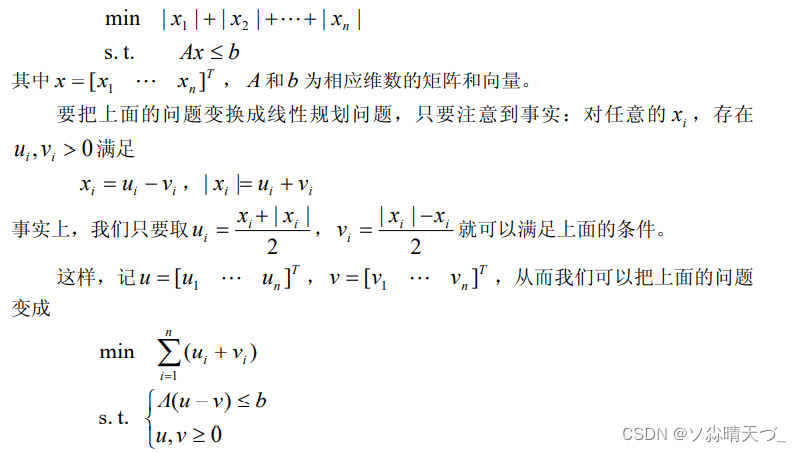
整数规划
分支定界算法
def integerPro(c, A=None, b=None, Aeq=None, beq=None,bounds=None, t=1.0E-8):
res = optimize.linprog(c, A_ub=A, b_ub=b, A_eq=Aeq, b_eq=beq,bounds=bounds)
bestVal = sys.maxsize
bestX = res.x
if not (type(res.x) is float or res.status != 0):
bestVal = sum([x * y for x, y in zip(c, bestX)])
if all(((x - math.floor(x)) <= t or (math.ceil(x) - x) <= t) for x in bestX):
return (bestVal, bestX)
else:
ind = [i for i, x in enumerate(bestX) if (x - math.floor(x)) > t and (math.ceil(x) - x) > t][0]
newCon1 = [0] * len(A[0])
newCon2 = [0] * len(A[0])
newCon1[ind] = -1
newCon2[ind] = 1
newA1 = A.copy()
newA2 = A.copy()
newA1.append(newCon1)
newA2.append(newCon2)
newB1 = b.copy()
newB2 = b.copy()
newB1.append(-math.ceil(bestX[ind]))
newB2.append(math.floor(bestX[ind]))
r1 = integerPro(c, newA1, newB1, Aeq, beq,bounds)
r2 = integerPro(c, newA2, newB2, Aeq, beq,bounds)
if r1[0] < r2[0]:
return r1
else:
return r2
指派问题
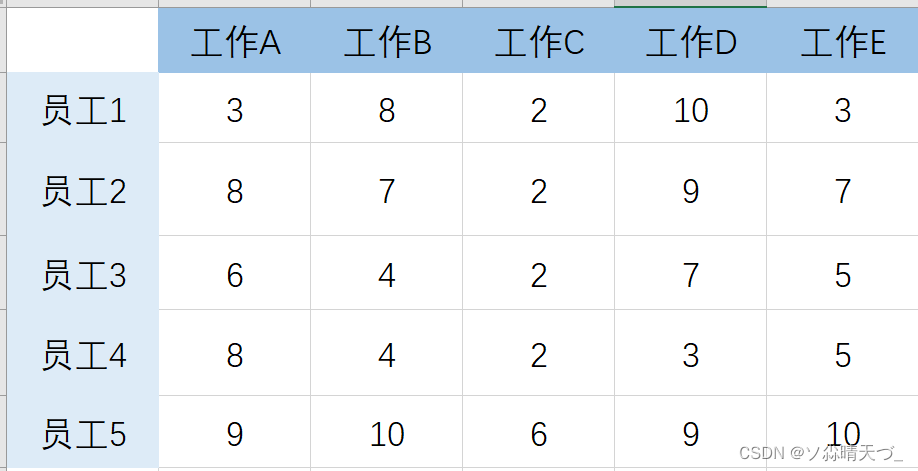
import numpy as np
from scipy import optimize
import math
import sys
cost_matrix = np.array([[3, 8, 2, 10, 3],
[8, 7, 2, 9, 7],
[6, 4, 2, 7, 5],
[8, 4, 2, 3, 5],
[9, 10, 6, 9, 10]])
row_ind,col_ind = optimize.linear_sum_assignment(cost_matrix, False)
print(row_ind)#行
print(col_ind)#列
print(cost_matrix[[row_ind],[col_ind]].sum())
[0 1 2 3 4]
[4 2 1 3 0]
21
非线性规划
非线性规划一般形式


非线性规划标准型

求解函数
def minimize(fun, x0, args=(), method=None, jac=None, hess=None,
hessp=None, bounds=None, constraints=(), tol=None,
callback=None, options=None)
fun:目标函
x0:初始猜测值
args(可选择参数):常量
bounds(可选择参数):范围[(min,max),…]
method(可选择参数):选择求解方法
constraints(可选择参数):约束条件,eq表示 函数结果等于0 ; ineq 表示 表达式大于等于0


import numpy as np
from scipy import optimize
import math
import sys
#目标函数
def fun(x):
return x[0] ** 2 + x[1] ** 2 + x[2] ** 2 + 8
#约束
constraints = [
{"type": "ineq", "fun": lambda x: x[0] ** 2 - x[1] + x[2] ** 2},
{"type": "ineq", "fun": lambda x: -(x[0] + x[1] ** 2 + x[2] ** 2 - 20)},
{"type": "eq", "fun": lambda x: -x[0] - x[1] ** 2 + 2},
{"type": "eq", "fun": lambda x: x[1] + 2 * x[2] ** 2 - 3}
]
x0 = (0, 0, 0) #猜测值
bounds = ((0, None) for i in range(3)) #范围
res = optimize.minimize(fun, x0, bounds=bounds, constraints=constraints)
print(res)
fun: 10.651091840572583
jac: array([1.10433471, 2.40651834, 1.89564812])
message: 'Optimization terminated successfully'
nfev: 71
nit: 15
njev: 15
status: 0
success: True
x: array([0.55216734, 1.20325918, 0.94782404])
或者加上args参数,将常数写args里面
args=[8]
#目标函数
def fun(x,args):
return x[0] ** 2 + x[1] ** 2 + x[2] ** 2 + args[0]
#约束
constraints = [
{"type": "ineq", "fun": lambda x: x[0] ** 2 - x[1] + x[2] ** 2},
{"type": "ineq", "fun": lambda x: -(x[0] + x[1] ** 2 + x[2] ** 2 - 20)},
{"type": "eq", "fun": lambda x: -x[0] - x[1] ** 2 + 2},
{"type": "eq", "fun": lambda x: x[1] + 2 * x[2] ** 2 - 3}
]
x0 = (0, 0, 0) #猜测值
bounds = ((0, None) for i in range(3)) #范围
res = optimize.minimize(fun, x0,args=args, bounds=bounds, constraints=constraints)
print(res)
fun: 10.651091840572583
jac: array([1.10433471, 2.40651834, 1.89564812])
message: 'Optimization terminated successfully'
nfev: 71
nit: 15
njev: 15
status: 0
success: True
x: array([0.55216734, 1.20325918, 0.94782404])
动态规划
以后补充
图与网络
最短路径
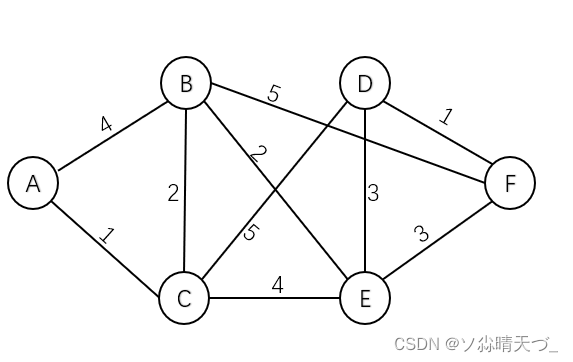
dijkstra算法
from math import inf
node_name = ['A', 'B', 'C', 'D', 'E', 'F']
# 邻接矩阵
map = [[0, 4, 1, inf, inf, inf],
[4, 0, 2, inf, 2, 5],
[1, 2, 0, 5, 4, inf],
[inf, inf, 5, 0, 3, 1],
[inf, 2, 4, 3, 0, 3],
[inf, 5, inf, 1, 3, 0]]
dist = [inf for i in range(len(map))]
path = [-1 for i in range(len(map))]
S = [0 for i in range(len(map))]
#起始点u
def dijkstra(u):
for i in range(len(map)):
dist[i] = map[u][i]
if dist[i] != inf:
path[i] = u
S[u] = 1
for i in range(len(map) - 1):
temp = inf
t = u
for j in range(len(map)):
if S[j] != 1 and dist[j] < temp:
t = j
temp = dist[j]
if t == u:
return
S[t] = 1
for j in range(len(map)):
if S[j] != 1 and dist[j] > dist[t] + map[t][j]:
dist[j] = dist[t] + map[t][j]
path[j] = t
def printPath():
for i in range(len(map)):
num = path[i]
p = node_name[i] + '->'
if num != -1:
while num != 0:
p += node_name[num] + '->'
num = path[num]
p += 'A'
print("路径:",p,"长度:",dist[i])
dijkstra(0)
printPath()
路径: A->A 长度: 0
路径: B->C->A 长度: 3
路径: C->A 长度: 1
路径: D->C->A 长度: 6
路径: E->C->A 长度: 5
路径: F->D->C->A 长度: 7
floyd算法
from math import inf
node_name = ['A', 'B', 'C', 'D', 'E', 'F']
# 邻接矩阵
map = [[0, 4, 1, inf, inf, inf],
[4, 0, 2, inf, 2, 5],
[1, 2, 0, 5, 4, inf],
[inf, inf, 5, 0, 3, 1],
[inf, 2, 4, 3, 0, 3],
[inf, 5, inf, 1, 3, 0]]
dist = map.copy()
path = [[-1 for i in range(len(map))] for j in range(len(map))]
def floyd():
for k in range(len(map)):
for i in range(len(map)):
for j in range(len(map)):
if dist[i][j] > dist[i][k] + dist[k][j]:
dist[i][j] = dist[i][k] + dist[k][j]
path[i][j] = k
def findPath(start, end):
if dist[start][end] < inf and path[start][end] == -1:
print('->{}'.format(node_name[end]),end='')
else:
mid = path[start][end]
findPath(start, mid)
findPath(mid, end)
def printPath(start,end):
print(node_name[start],end='')
findPath(start,end)
print(' 最短路径长度为:',dist[start][end])
floyd()
#A到F的路径
printPath(0,5)
A->C->D->F 最短路径长度为: 7
最小生成树
prim
from math import inf
node_name = ['A', 'B', 'C', 'D', 'E', 'F']
# 邻接矩阵
map = [[0, 4, 1, inf, inf, inf],
[4, 0, 2, inf, 2, 5],
[1, 2, 0, 5, 4, inf],
[inf, inf, 5, 0, 3, 1],
[inf, 2, 4, 3, 0, 3],
[inf, 5, inf, 1, 3, 0]]
# 节点个数
n = len(map)
dist = [inf for i in range(n)]
S = [0 for i in range(n)]
path = [-1 for i in range(n)]
# v是开始结点
def prim(v):
for i in range(n):
dist[i] = map[v][i]
if map[v][i] != inf:
path[i] = v
S[v] = 1
for i in range(n - 1):
min = inf
t = v
for j in range(n):
if S[j] != 1 and min > dist[j]:
min = dist[j]
t = j
S[t] = 1
print(node_name[path[t]], '->', node_name[t])
for j in range(n):
if S[j] != 1 and dist[j] > map[t][j]:
dist[j] = map[t][j]
path[j] = t
prim(0)
if sum(dist) == inf:
print("无法生成最小生成树")
else:
print("最小权值:", sum(dist))
A -> C
C -> B
B -> E
E -> D
D -> F
最小权值: 9
kruskal
以后补充
层次分析
参考:https://blog.csdn.net/weixin_43819566/article/details/112251317
import numpy as np
n = 5
RI = [0, 0, 0.52, 0.89, 1.12, 1.26, 1.36, 1.41, 1.46, 1.49, 1.52, 1.54, 1.56, 1.58, 1.59]
# 选择旅游地
A = np.array([[1, 1 / 2, 4, 3, 3],
[2, 1, 7, 5, 5],
[1 / 4, 1 / 7, 1, 1 / 2, 1 / 3],
[1 / 3, 1 / 5, 2, 1, 1],
[1 / 3, 1 / 5, 3, 1, 1]])
# 景色
B1 = np.array([[1, 2, 5],
[1 / 2, 1, 2],
[1 / 5, 1 / 2, 1]])
# 花费
B2 = np.array([[1, 1 / 3, 1 / 8],
[3, 1, 1 / 3],
[8, 3, 1]])
# 居住
B3 = np.array([[1, 1, 3],
[1, 1, 3],
[1 / 3, 1 / 3, 1]])
# 饮食
B4 = np.array([[1, 3, 4],
[1 / 3, 1, 1],
[1 / 4, 1, 1]])
# 交通
B5 = np.array([[1, 1, 1 / 4],
[1, 1, 1 / 4],
[4, 4, 1]])
matrixs = [A, B1, B2, B3, B4, B5]
res = np.zeros((5, 4))
for i in range(len(matrixs)):
# 求解特征值和特征向量
res1 = np.linalg.eig(matrixs[i])
# 特征值
v = res1[0][0]
# 权重向量
w = res1[1][:, 0]
# 权重向量归一化
w = w / sum(w)
CI = (v - n) / (n - 1)
CR = CI / RI[n - 1]
# print(v)
# print(w)
if i == 0:
res[:, 0] = w
else:
res[i - 1, 1:] = w
#权重矩阵
print(res)
score = []
for i in range(res.shape[1] - 1):
score.append(np.sum(res[:, 0] * res[:, i + 1]))
print("苏杭得分:",score[0])
print("北戴河得分:",score[1])
print("桂林得分:",score[2])
[[0.26360349 0.59537902 0.27635046 0.12827052]
[0.47583538 0.08193475 0.2363407 0.68172455]
[0.0538146 0.42857143 0.42857143 0.14285714]
[0.09806829 0.63370792 0.19192062 0.17437146]
[0.10867824 0.16666667 0.16666667 0.66666667]]
苏杭得分: 0.2992545297453049
北戴河得分: 0.24530398001537013
桂林得分: 0.4554414902393249
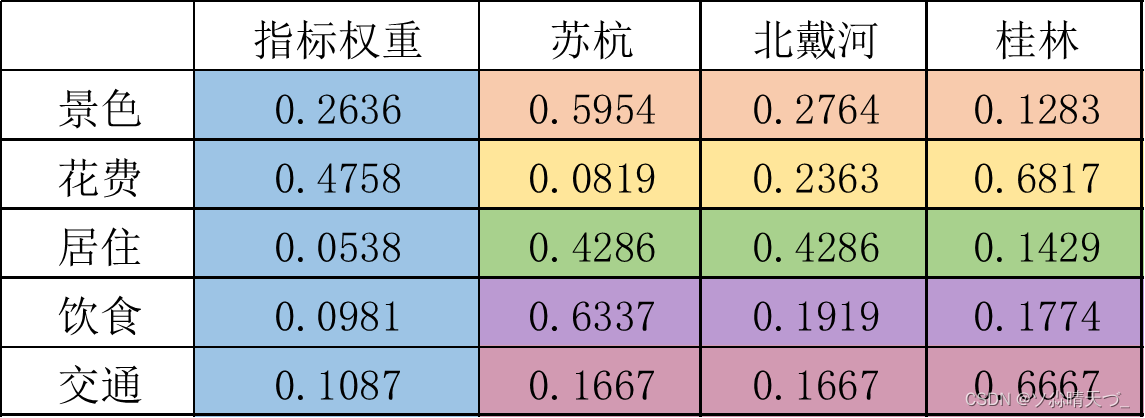
灰色关联度分析
系统分析
参考:https://blog.csdn.net/weixin_43819566/article/details/112914383
下表为某地区国内生产总值的统计数据(以百万元计),问该地区从 2000 年到 2005 年之间,哪一种产业对 GDP 总量影响最大。
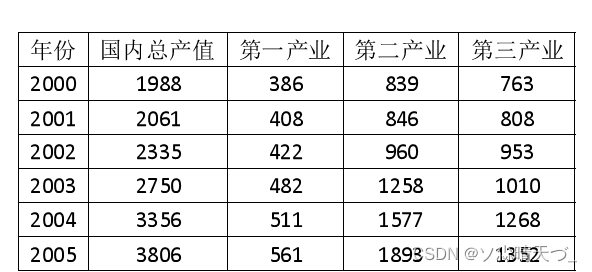
import numpy as np
x = np.array([[1988, 386, 839, 763],
[2061, 408, 846, 808],
[2335, 422, 960, 953],
[2750, 482, 1258, 1010],
[3356, 511, 1577, 1268],
[3806, 561, 1893, 1352]], dtype='float')
average = x.mean(axis=0)
# 分辨系数
p = 0.5
for i in range(x.shape[1]):
x[:, i] = x[:, i] / average[i]
y = np.zeros((x.shape[0], x.shape[1] - 1))
# 得到差值矩阵
for i in range(x.shape[1] - 1):
y[:, i] = np.abs(x[:, i + 1] - x[:, 0])
# 两级最小差
a = y.min()
# 两级最大差
b = y.max()
# 得到关联系数矩阵
y = (a + p * b) / (y + p * b)
r=y.mean(axis=0)
print("关联系数矩阵")
print(y)
print("关联度")
print(r)
关联系数矩阵
[[0.4751452 0.6586359 0.89222807]
[0.42986317 0.57328932 0.76795519]
[0.63557702 0.54618164 0.57663015]
[0.75204756 0.89847974 0.7752663 ]
[0.42237767 0.66568635 1. ]
[0.33558385 0.40350205 0.53171804]]
关联度
[0.50843241 0.62429583 0.75729962]
综合评价
1、对指标进行正向化
2、对正向化矩阵进行预处理
3、将预处理后的具有真每一行取出最大值构成母序列
4、计算各个指标与母序列的灰色关联度
5、计算各个指标的权重
6、计算每个评价对象的得分
灰色预测
参考:https://blog.csdn.net/weixin_43819566/article/details/113819188
预测计算

import numpy as np
from numpy.linalg import inv
from math import e
x0 = np.array([71.1, 72.4, 72.4, 72.1, 71.4, 72.0, 71.6])
print("参考数据:", x0)
n = x0.shape[0]
# 求级比
jibi = np.array([x0[i] / x0[i + 1] for i in range(n - 1)])
print("级比:", jibi)
# 可容覆盖区间
X = (pow(e, -2 / (n + 1)), pow(e, 2 / (n + 1)))
# 校验级比是否都在可容覆盖区间
if np.min(jibi) >= X[0] and np.max(jibi) <= X[1]:
print("级比都落在可容覆盖区间,通过级比检验")
else:
print("不满足条件")
# GM(1,1)建模
# 原始数据累加
x1 = np.array([np.sum(x0[:i + 1]) for i in range(n)])
print("累加生成数列", x1)
Z = np.array([0.5 * x1[i] + 0.5 * x1[i + 1] for i in range(n - 1)])
print(Z)
B = np.ones((n - 1, 2), dtype=float)
B[:, 0] = -Z
Y = x0[1:].reshape((n - 1, 1))
"""
u=(a,b)T=(BTB)-1BTY
"""
u = inv((B.T @ B)) @ B.T @ Y
a, b = u[0, 0], u[1, 0]
print("a=", a, "b=", b)
# 预测值
# 需要预测的数量
count = n
res = []
x2 = np.array([(x0[0] - b / a) * pow(e, -a * k) + b / a for k in range(count)])
res.append(x2[0])
for i in range(1, count):
res.append(x2[i]-x2[i-1])
res=np.array(res)
print("预测值:", np.round(res,4))
# 检验
# 残差检验
cancha=[1-res[i]/x0[i] for i in range(n)]
print("残差:",cancha)
if max(cancha)<0.1:
print("达到较高要求")
#
参考数据: [71.1 72.4 72.4 72.1 71.4 72. 71.6]
级比: [0.9820442 1. 1.00416089 1.00980392 0.99166667 1.00558659]
级比都落在可容覆盖区间,通过级比检验
累加生成数列 [ 71.1 143.5 215.9 288. 359.4 431.4 503. ]
[107.3 179.7 251.95 323.7 395.4 467.2 ]
a= 0.0023437864785236795 b= 72.65726960367881
预测值: [71.1 72.4057 72.2362 72.0671 71.8984 71.7301 71.5622]
残差: [2.042810365310288e-14, -7.930166340575084e-05, 0.002261925940694187, 0.0004559153760241852, -0.006980620867546694, 0.003748623322583966, 0.0005282688652282763]
达到较高要求
插值
拉格朗日多项式插值
避免Runge现象的常用方法是:将插值区间分成诺干小区间,在小区间内用低次(二次,三次)插值,既分段低次插值
给出结点x0=-1,x1=1,x2=2处的函数值为y0=2,y1=1,y2=3,要求计算出它的拉格朗日插值多项式,并计算f(0.5)的值
def lagrange(x0, y0, x):
y = []
for i in range(len(x)):
s = 0
for j in range(len(x0)):
p = 1
for k in range(len(x0)):
if j != k:
p *= (x[i] - x0[k]) / (x0[j] - x0[k])
s += p * y0[j]
y.append(s)
return y
x0 = [-1, 1, 2]
y0 = [2, 1, 3]
x = [0.5]
print(lagrange(x0, y0, x))
[0.625]
import numpy as np
from matplotlib import pyplot as plt
plt.rcParams['font.sans-serif'] = ['SimHei'] # 用来正常显示中文标签
plt.rcParams['axes.unicode_minus'] = False # 用来正常显示负号
x0 = np.arange(-np.pi, np.pi, 1) # 定义样本点X,从-pi到pi每次间隔1
y0 = np.sin(x0) # 定义样本点Y,形成sin函数
x = np.arange(-np.pi, np.pi, 0.1)
y = np.array(lagrange(x0, y0, x))
plt.plot(x0, y0, 'o', label='样本点')
plt.plot(x, y, label="插值点")
plt.yticks(ticks=[-1.5+i*0.25 for i in range(13)])
plt.title('拉格朗日插值')
plt.legend()
plt.show()

分段线性插值
import numpy as np
from matplotlib import pyplot as plt
x = range(0, 26, 2)
y = [12, 9, 9, 10, 18, 24, 28, 27, 25, 20, 18, 15, 13]
x1 = 13
y1 = np.interp(x1, x, y)
print((x1,y1))
(13, 27.5)
import numpy as np
from matplotlib import pyplot as plt
plt.rcParams['font.sans-serif'] = ['SimHei'] # 用来正常显示中文标签
plt.rcParams['axes.unicode_minus'] = False # 用来正常显示负号
x = np.arange(-np.pi, np.pi, 1) # 定义样本点X,从-pi到pi每次间隔1
y = np.sin(x) # 定义样本点Y,形成sin函数
x1 = np.arange(-np.pi, np.pi, 0.1)
y1 = np.interp(x1, x, y)
plt.plot(x,y,'o',label='样本点')
plt.plot(x1,y1,label="插值点")
plt.yticks(ticks=[-1.5+i*0.25 for i in range(13)])
plt.title('线性插值')
plt.legend()
plt.show()
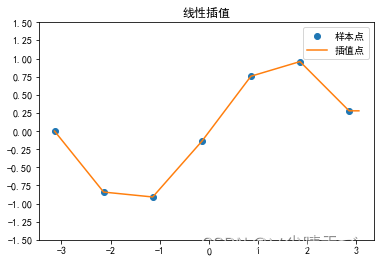
三次样条插值
三次样条插值更加的圆滑
import scipy.interpolate as spi
import numpy as np
from matplotlib import pyplot as plt
plt.rcParams['font.sans-serif'] = ['SimHei'] # 用来正常显示中文标签
plt.rcParams['axes.unicode_minus'] = False # 用来正常显示负号
x = np.arange(-np.pi, np.pi, 1) # 定义样本点X,从-pi到pi每次间隔1
y = np.sin(x) # 定义样本点Y,形成sin函数
x1 = np.arange(-np.pi, np.pi, 0.1)
ipo = spi.splrep(x, y, k=3) # 样本点导入,生成参数
y1 = spi.splev(x1, ipo) # 根据观测点和样条参数,生成插值
plt.plot(x,y,'o',label='样本点')
plt.plot(x1,y1,label="插值点")
plt.yticks(ticks=[-1.5+i*0.25 for i in range(13)])
plt.title('三次样条插值')
plt.legend()
plt.show()
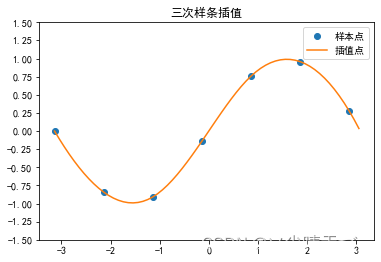






















 3590
3590











 被折叠的 条评论
为什么被折叠?
被折叠的 条评论
为什么被折叠?








